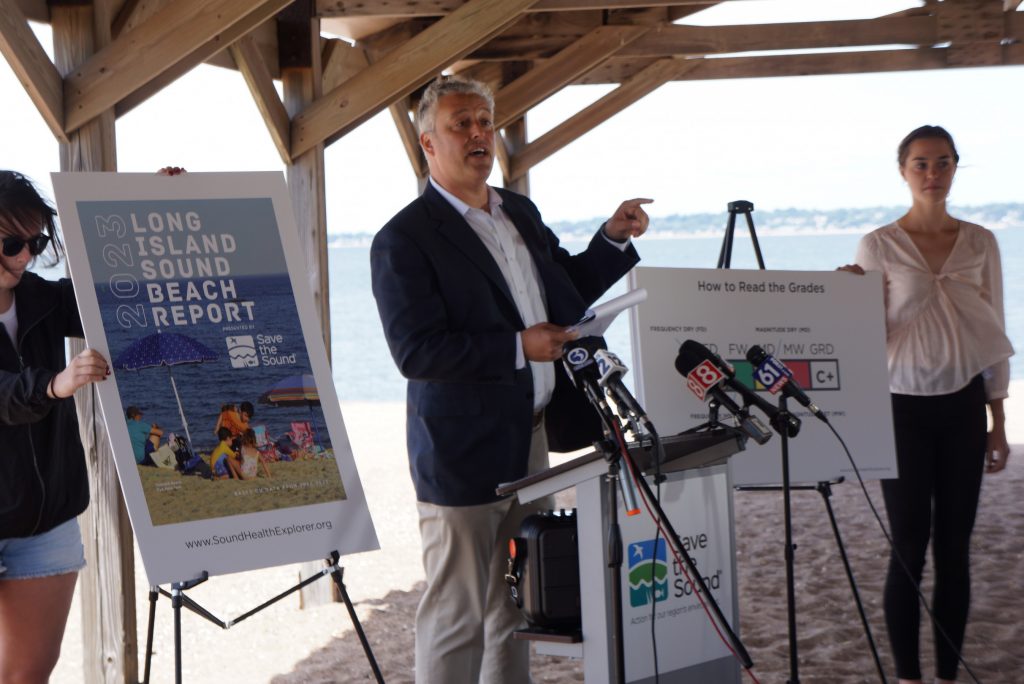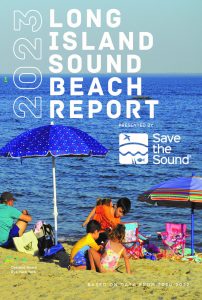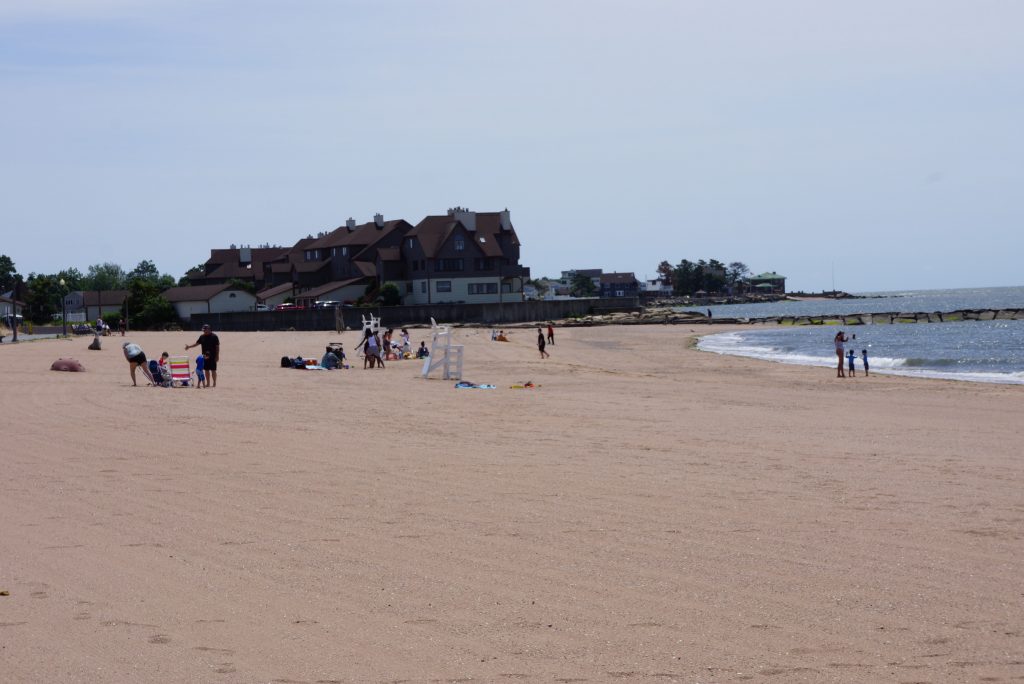FIRST DAY OF SUMMER BRINGS GOOD NEWS FOR LOCAL BEACHGOERS
Water Quality at Most Long Island Sound Public Beaches Earns High Marks; Impact of Increasing Rain Events a Cause for Concern
PORT WASHINGTON, New York/NEW HAVEN, Connecticut — June 21, 2023 – The first day of summer marked an auspicious moment for regional nonprofit organization Save the Sound to release results of its 2023 Long Island Sound Beach Report. Staff from Save the Sound were joined on June 21 by local officials and clean water advocates during simultaneous events at North Hempstead Beach Park in Port Washington, NY and Lighthouse Point Park in New Haven, CT to reveal updated grades for over 200 beaches around the Long Island Sound shoreline. The biennial report offered generally positive news for swimmers and beachgoers, noting that 78% of the Long Island Sound beaches monitored earned “A” or “B” grades for water quality. There were concerning signs, however, indicating that residents and local officials must remain vigilant – as beach closures or “failures” due to poor water quality after rain events increased in several regions compared to the previous 2021 report. Also concerning, New York City-area beaches continue to grade poorly relative to other regions of the Sound over the 2020-2022 period.
A far cry from decades past when people were not comfortable swimming in the Sound – the 2023 Long Island Sound Beach Report demonstrates that water quality at most swimming beaches in the Sound is good to excellent in respect to safe swimming. Thanks to years of advocacy and investment by environmental leaders like Save the Sound; municipal governments; the States of Connecticut and New York; the EPA; and concerned shoreline residents, the Sound is now ringed with many beaches that consistently provide water quality meeting safe swimming criteria. The report presented comprehensive grades for 198 of 207 monitored swimming beaches (with 9 beaches reporting insufficient data for a grade in 2022). 155 beaches earned a “B-” grade or above during the 2022 swimming season. To illustrate this positive news further, Save the Sound included a list of the “Top 20” public beaches on Long Island Sound based on their most recent three-year average water quality (10 each in NY and CT).
Top 20 public beaches on Long Island Sound with the best grades for water quality:
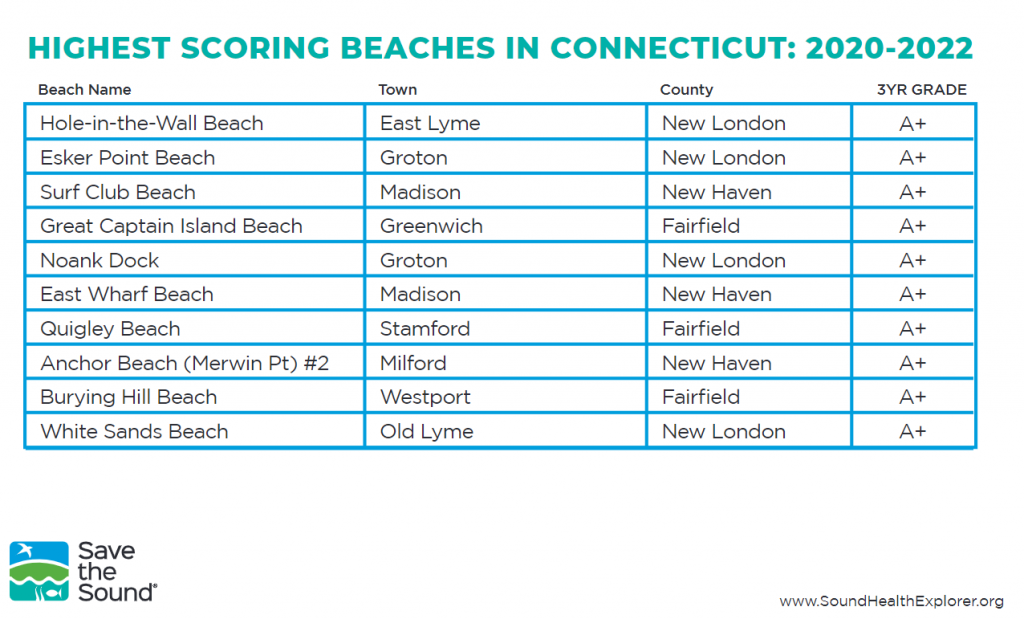
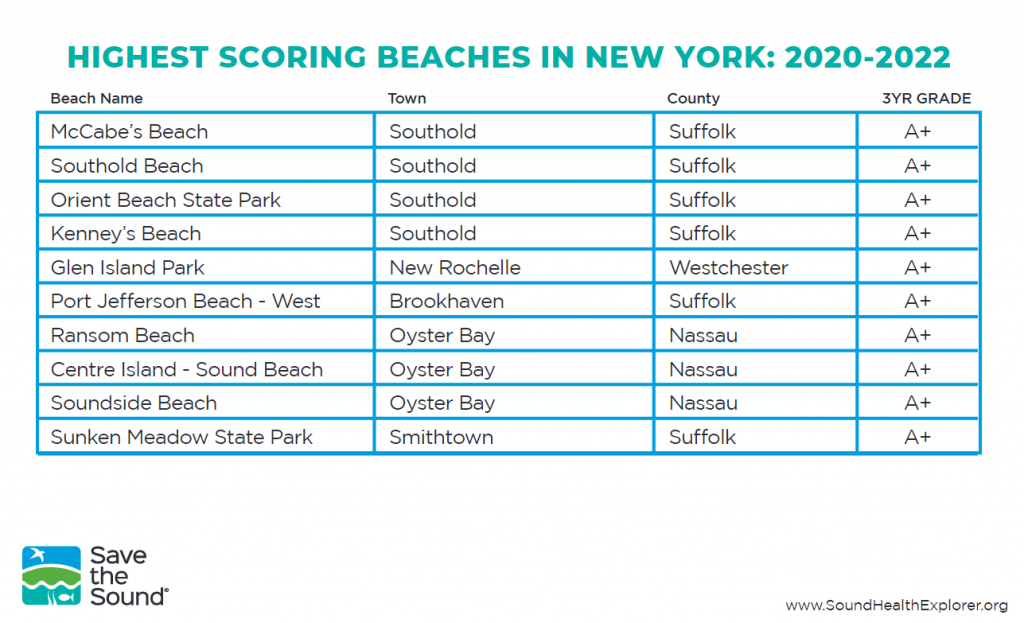
There were, however, storm clouds gathered on the edge of the positive news. They were literal storm clouds, in fact, as the report revealed that increasing rain events over the past three years have triggered an increasing number of beach sample failures. The overall failure rate of beach samples was nearly three times as high in wet weather than in dry weather – 13.5% to 5.2%. This is an even greater disparity than monitored in the 2021 Beach Report. Moreover, the frequency of wet weather fails increased 2.1% for the 2023 report.
Beach closures and failures after rain events (often the day after rainfall ends, sometimes lasting several days) are concerning for several reasons. First, elevated levels of fecal contamination after rain can often indicate untreated sewage has made its way into a system of pipes only designed for stormwater. Second, beaches with abundant wet weather failures have large swaths of impervious surfaces (e.g. roads, roofs, parking lots) that are leading to high volumes of stormwater flow to beaches. Third, rainfall intensity and frequency are increasing due to climate change, raising the stakes.
From 2020 to 2022, the region experienced the most rain during a three-year period that has been recorded in a decade. The areas surrounding Long Island Sound received an average of 17 inches of rain during the swimming season – a number exacerbated by the 23 inches of rain that fell in 2021, the highest total since Save the Sound began tracking the data in 2009. The only three-year period that saw more rainfall was 2011-2013, when the area averaged 18.3 inches, a stretch that included Hurricane Irene one year and Superstorm Sandy the next. This trend threatens to reverse the improvements in water quality secured over recent years. If those improvements are to be maintained or enhanced, it’s clear that investments towards improving local stormwater systems are crucial.
Stormwater pipe discharges are one factor that influences the “hyper-locality” of water quality at local beaches. Good water quality at one beach doesn‘t necessarily predict good quality at a neighboring beach, especially if the neighboring beach has a stormwater outflow pipe feeding into it. Take the case of two neighboring beaches in New Haven County, CT. Despite being separated by only a few hundred feet, one beach earns an A+, while the other earns a C+ for its most recent three-year average. This difference can be largely explained by the presence of a stormwater pipe that discharges directly into the water of the second beach during rain events.
David Ansel, vice president of water protection for Save the Sound, commented, “Water quality at beaches across Long Island Sound has come so far – but we may be at a tipping point. Increasing rainfall brought on by climate change threatens to undo decades of progress unless we act now. We’re calling on elected officials to prioritize investment in repairs and improvements to sewer lines and stormwater systems. Steps we take in the next five years may well set the course for the health of Long Island Sound over the next 50.”
“The Long Island Sound is a multi-trillion dollar asset that powers Connecticut’s economy, but it’s also a defining feature of our state’s culture. Today’s report shows that the quality of our beaches has come a long way in recent decades, but we’ve still got room for improvement,” said U.S. Senator Chris Murphy of Connecticut. “In the past seven years, I helped secure a tenfold increase in funding for the Sound, and as a member of the Appropriations Committee, I’ll keep pushing for more federal support to improve water quality and protect beaches for future generations.”
Save the Sound also raised concerns about limits on beach access in the region, noting that nearly one-third of the monitored beaches are designated as private. Many beaches have restrictions on use by non-residents, such as onerous fees. For example, at a beach in Connecticut, non-residents are allowed access during the swimming season but must pay a daily parking fee of $70 on weekends and holidays between May 1 and September 30. Staffers urged local communities to find a balance when setting fees or policies for beach access, so that everyone can enjoy Long Island Sound.
Save the Sound has created a dedicated website—www.SoundHealthExplorer.org—which features interactive maps listing beach water quality at all 207 monitored beaches, and from which the full Beach Report can be downloaded. The site also features a “beach access” section including information on which beaches offer public access, fees, the location of kayak and canoe entry ramps, and more useful information. The site highlights two decades of water quality data for Long Island Sound.
About Save the Sound
Save the Sound leads environmental action in the Long Island Sound region. We protect the Sound and its rivers, fight climate change, save endangered lands, and work with nature to restore ecosystems. For 50 years we’ve been ensuring people and wildlife can enjoy the healthy, clean, and thriving environment they deserve. From our offices in Larchmont, NY and New Haven, CT, Save the Sound works for a cleaner, healthier, and more vibrant Long Island Sound. The organization’s success is based on scientific knowledge, legal expertise, and thousands of ordinary people teaming up to achieve results that benefit the environment for current and future generations. Learn more at www.savethesound.org.
###

